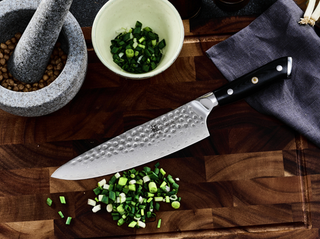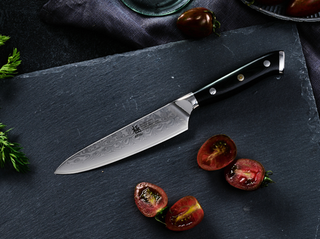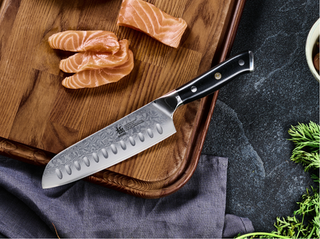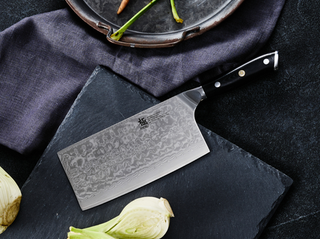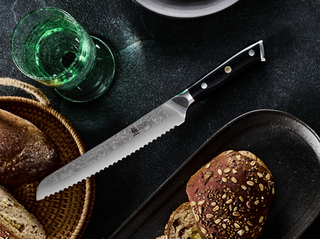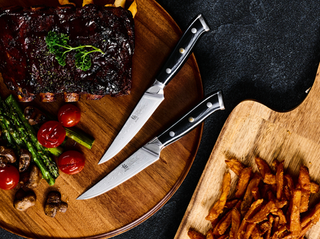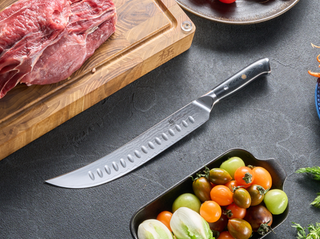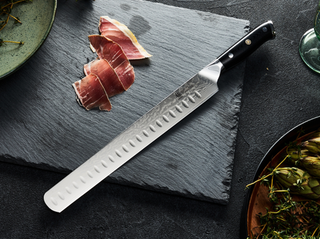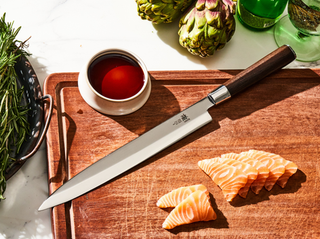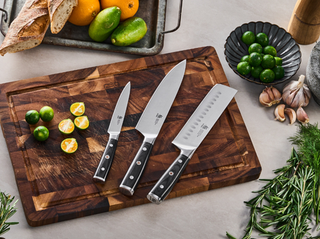Using a sharp object incorrectly is one of the quickest ways to injure yourself in the kitchen. That's one reason why, if you wish to learn basic cooking, it’s important to master your abilities at using a knife.
Learning a knife skill can take your cooking to another level. Plus, employing the right kitchen techniques makes preparing even simple recipes far more efficient and enjoyable.
How to get there? Fear not, adventurous chefs! Today, we will look into 5 of the easiest and simplest techniques and tips to improve knife skills in the kitchen. Read through the blog to get that expert chopping and slicing.

What is Precision Cutting?
In the culinary world, precision cutting is the king of efficiency. Creating perfect dishes requires you to use your knife with accuracy and control to achieve perfect uniform sizes. This not only helps with the visual appeal of your dishes but also with the cooking experience.
So whether you're dicing vegetables for a stew or julienning herbs for a garnish, precision cutting can help you get consistent pieces.
But do you know precision cutting is more than just about knives? It requires proper handling and practice. Let’s get you to master these expert skills for the ultimate knife-cutting experience.
Tips to Improve Knife Skills
1- Use the right kind of knife.
The most basic and important factor in achieving a precision cut is the choice of your tool. You must get your hands on a sharp knife set that can help you deliver the right cuts. Without the right kind of tool, you can end up with uneven cuts.
If you do not have a sharp knife set, we recommend you look for Kyoku Knives.
This site will let you step into the true experience of professional knives suitable for cutting of all kinds. The best part is that they do not offer just one or two pieces; instead, they have a wide variety, catering to each need. You can pick a 4-piece Steak Knife Set 440C Steel for your clean steak cuts or a 4.5" Paring Knife for a finer chop.
2- practice proper handling.
How you hold your knife can be another critical factor that impacts your cutting technique.
Many amateur chefs tend to grip the handle tightly to get more control over the tool. However, it is quite the opposite. Instead of gripping the handle tightly, use your palm to hold it, with your thumb and index finger gripping the base of the blade. This grip allows for more control and reduces strain on your wrist.
You can use your non-dominant hand, or "helping hand,” to stabilize the food. But make sure to curl your fingers into a claw shape. This helps protect them and guide the knife along your knuckles. As you cut through, move your hand back gradually to create consistent slices.
Practicing this grip and technique gives you better control over the blade.
3- Know the different cuts.
Once you've learned how to maintain and manage your kitchen knives correctly, you can start practicing some of the basic knife techniques. Having these diverse cutting techniques down is the best approach to showing off your knife art as you improve it.
Chop
The chop is your go-to move when dealing with a mountain of veggies or a hefty chunk of meat. It's all about speed and efficiency, not perfection. Think of it as the kitchen equivalent of rough-and-tumble play – it gets the job done! Just try to keep your pieces similar in size so everything cooks evenly.
Dice
Dicing is where you start to show off your knife skills. You’re aiming for tiny, uniform cubes that add a delightful texture to your dishes. Imagine building little culinary bricks. It might take a bit of practice, but the payoff is huge. Think of an onion: first, you slice it into planks, then stack ‘em up and chop ‘em down into dice-sized pieces.
Slice
Slicing is all about creating elegant, paper-thin pieces. It's like slicing through a masterpiece. A straight-edged knife is your best friend for firmer foods like carrots or potatoes. But when you're tackling something soft, like a ripe tomato or a crusty loaf of bread, a serrated knife is the way to go.

4- Maintain your blades.
While having the right kind of knife can make a difference, it won’t be much of use if they’re not kept right. Plus, it is also crucial for your safety.
Dull blades can slow you down and increase the risk of accidents. That is why it is recommended to sharpen your blades regularly. You can use a knife sharpener or honing steel to keep your blades in peak condition.
How do knife sharpeners work? It’s simple: They shave the blade’s edge to create the ideal angle for slicing. After a few drags through the sharpener, test your knife by slicing through a sheet of paper—if it cuts cleanly, your blade is sharp. With honing steels, you don’t have to shave off the material. Simply repeatedly draw the blade across the honing steel at the desired angle until you achieve the desired sharpness.
Cleaning and storing are another vital aspect of keeping your knives in the best condition. Try washing them immediately after use to avoid damage, and store them in a knife block or on a magnetic strip to prevent chips and nicks.
5- Learn and practice.
Improving your knife skills takes time and practice. The more you use your knives, the better you'll become. Therefore, starting with simple tasks and slowly challenging yourself with more complex cuts is best.
Nonetheless, focus on safety and technique during your practice sessions. Consistent effort can help you improve and gain more confidence over time.

Conclusion!
Congratulations! You've unlocked the secret to precise cutting. With these simple steps and helpful tips, you can transform your culinary skills into an art. Now, conquer your next culinary challenge: slicing veggies or getting the perfect steak cut.
Frequently Asked Questions
Q1: Why is using the right knife important?
A1: The right knife helps you make cleaner, more precise cuts, which improves your cooking and keeps you safe. Sharp, good-quality knives make chopping and slicing easier and more enjoyable.
Q2: How can I protect my fingers while cutting?
A2: Use your non-dominant hand to hold the food with fingertips curled inward in a claw shape. This guides the knife safely along your knuckles and keeps your fingers out of harm’s way.
Q3: What are some common knife cuts beginners should practice?
A3: Start with chopping for quick, rough cuts; dicing for uniform cubes; and slicing for thin, elegant pieces. Each cut serves different purposes and improves your kitchen skills over time.
Q4: How often should I sharpen my knives?
A4: Regular sharpening is key to maintaining a sharp edge and safe cutting. You can use a sharpener or honing steel to keep your blades in top condition. Test sharpness by slicing through paper—if it slices cleanly, your knife is ready.
Q5: Any tips for caring for knives between uses?
A5: Wash knives right after use to avoid damage and store them properly in a knife block or on a magnetic strip to prevent dulling or chipping.
Q6: How can I keep improving my knife skills?
A6: Practice regularly! Start simple, focus on technique and safety, and gradually challenge yourself with more complex cuts. With time and consistent effort, your confidence and skill will grow.
